Solar energy, emitted by the sun, comprises bundles of energy called photons, each carrying energy defined by Einstein’s equation (hf). It plays a crucial role in sustaining life on Earth, being a primary source for photosynthesis in plants, providing warmth to all living beings, and aiding in the evaporation of water, leading to the formation of clouds and eventually fresh rainwater.
The immense solar energy originates from the sun’s fusion reactions, converting about four hundred million tons of its mass into energy every second.
The sun’s nuclear fusion reactions, particularly the proton-proton cycle, involve several stages. These reactions begin with the fusion of two protons to form a deuterium nucleus (a hydrogen nucleus with two protons and a neutron). In subsequent steps:
The First Step: Fusion of two protons to form a deuterium nucleus (a hydrogen nucleus consisting of two protons and one neutron).
The Second Step: Fusion of a deuterium nucleus with another proton to form helium-3.
The Third Step: Fusion of a helium-3 nucleus with another helium-3 nucleus to form
This process converts protons into neutrons and releases energy as gamma rays.
Despite its intensity, solar energy reaching Earth’s surface is relatively low due to the vast distance between the Earth and the sun, and Earth’s atmosphere absorbing and scattering the radiation. On a clear day with direct sunlight, only about 30% of the solar energy penetrates the atmosphere. This percentage decreases significantly when the sun is near the horizon or the sky is cloudy. The amount of solar radiation also varies across different locations on Earth.
The total amount of solar energy received by Earth far exceeds global energy usage. If harnessed effectively, this widespread source could meet all future energy needs, given its renewable and non-polluting nature. Consequently, solar energy usage is expected to increase in the 21st century, while the use of limited and polluting fossil fuels like coal, oil, and natural gas is likely to decrease.
Solar panels
Solar panels are the most common devices for harvesting solar energy. They consist of a dark metallic sheet covered by one or two glass layers that absorb heat. This heat is then transferred to air or water, known as the heat-carrying fluids, flowing through the back of the panel. This heat can be used directly or transferred to another medium. Flat panel collectors, used for heating homes and water, can reach temperatures of 150 to 200 degrees Fahrenheit (66 to 93 degrees Celsius) with an efficiency rate of up to 80%.
For higher temperatures, more concentrated collectors are used. These devices focus sunlight from a large area onto a small, black receiver, significantly intensifying the radiation to produce high temperatures. Solar furnaces using arrays of mirrors or panels can heat fluids to 3600 degrees Fahrenheit (2000 degrees Celsius) or more. This heat can be used for material properties research at high temperatures or to operate boilers generating steam for electric power plants. Solar furnaces have become crucial tools in high-temperature research and steam production.
Solar Power Towers Solar power towers use reflective blades or flat mirrors that track the sun’s movement across the sky. The mirrors are arranged around a central ‘collector tower,’ reflecting sunlight into a concentrated beam that focuses on a point on the tower. Earlier designs heated water in a tank to generate steam for turbines. Recently, some towers have used liquid sodium, which has a higher heat capacity and retains heat longer. This means the liquid not only reaches temperatures of 773 to 1,273 Kelvin (500 to 1000 degrees Celsius or 932 to 1,832 degrees Fahrenheit) but can also continue boiling water and generating power even when the sun isn’t shining.
The first concentrated solar power plants were developed in the 1980s. The world’s largest facility is a series of plants in the Mojave Desert, California. The Solar Energy Generating Systems (SEGS) produce over 650 gigawatt-hours of electricity annually, with other large and efficient plants developed in countries like Spain and India.
Concentrated solar power can also be used on a smaller scale. For example, people in villages worldwide use solar-powered stoves to boil water for cooking.
Solar-powered stoves offer several advantages over wood-burning stoves: they pose no fire hazard, produce no smoke, require no fuel, and do not contribute to deforestation.
Photovoltaic cells
are a means to generate electric power by converting light directly into electricity using semiconductors. Solar panels consist of several solar cells containing photovoltaic materials such as monocrystalline silicon, polycrystalline silicon, amorphous silicon, cadmium telluride, and gallium indium selenide-sulfide. Due to increasing demand for renewable energy sources, the manufacturing of solar cells and photovoltaics has significantly evolved in recent years.
The capacity of photovoltaic cells has grown rapidly, reaching 46,400 megawatts by the end of 2011, representing 0.5% of global electricity demand, with over 100 countries using photovoltaic solar energy. Solar cells can be installed on the ground (sometimes used with agriculture or grazing) or built into the roof or walls of a building (building-integrated photovoltaics).
Advantages of Photovoltaic Cells
- Solar panels optimally utilize 98% of sunlight, providing over 6000 times the average human energy needs (15%).
- They do not cause pollution during operation, producing no waste or emissions and requiring no pollution control or recycling technologies.
- Solar panels have a long lifespan and require minimal maintenance, with very low capital and operating costs compared to alternative technologies.
- Connecting solar power collectors to the electrical grid reduces losses, maintaining an efficiency rate exceeding 40%.
Disadvantages of Photovoltaic Cells
- The use of photovoltaic cells was excluded in Europe due to hazardous material restrictions since 2003, continuing until 2011.
- Photovoltaic panels in Europe and California contain banned substances like lead, mercury, and cadmium, impacting electronics legislation.
- Some U.S. states impose significant restrictions on using solar panels in homes.
- Berkeley shows an innovative initiative using the PACE financing model to overcome these restrictions.
- The development of vertical solar panels and vertical installation enhances efficiency and improves orientation towards the sun.
Photovoltaic cells and solar energy represent a tremendous advancement in clean and sustainable energy generation. Thanks to technological development and innovation in solar cell manufacturing, this method has become an effective and sustainable way to meet a significant portion of global energy needs.
Written by Khaled Al-Abdo – Physics Teacher at Masarat Initiative





